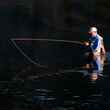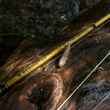Mining is essential. The device you’re reading this on requires mined minerals. The same goes for your vehicle, your house, the symbol of your marriage. Like it or not, these necessities require minerals that must be extracted from the ground through sulfide mining.
Sulfide mining is, essentially, the process of removing trace valuable minerals from large quantities of rock. Doing so generally requires significant depletion of groundwater, because miners need to dig below the water table and continually pump out the water that would fill up the giant holes otherwise. The sulfide ore, or the rock left over after the valuable minerals have been taken out, can release sulfuric acid when exposed to air and water. When you hear about mines storing waste, this is usually what they’re talking about. Sulfuric acid is dangerous to ecosystems in its own right, but it has the added drawback of freeing heavy metals like mercury that are trapped in many types of rock. Point is, sulfide mines, though necessary, do have a long and well-earned history of degradation and pollution.
Not all mine sites, however, present an equal environmental threat. Ask any real estate developer (say, perhaps, our president), location matters. Sulfide mines near creeks, streams, rivers and lakes are particularly problematic. The acids and minerals “mobilized” by these operations can travel, contaminating drinking and groundwater, and severely impacting fisheries. Over the past year, a flurry of proposed sulfide mines near sensitive waters have progressed toward reality, or been resurrected from permitting purgatory. Here’s a rundown on the status of mining projects that may be coming to a favorite fishery near you.
Pebble Mine
Proposed site: Bristol Bay, Alaska.
Minerals: Gold, Copper, and Molybdenum.
Mining companies: Northern Dynasty Minerals–Vancouver, Canada and First Quantum Minerals–Vancouver, Canada.
Watersheds potentially affected: Upper Talarik Creek, Koktuli River, Kvichak River, Mulchatna River, Nushagak River, Lake Iliamna, Lake Clark, Bristol Bay near Dillingham.
Reasons for concern: Potential contamination of ground and surface water in one of the last remaining healthy ecosystems that supports populations of Pacific Salmon. Significant road and other infrastructure development in currently undisturbed and sensitive tundra habitat.
Status: Like the Walking Dead—both the zombies and the show itself—this project just won’t go away. Pebble Mine is arguably the most publicized, criticized, and hotly debated mining proposal in modern American history. In the summer of 2014, the EPA proposed restrictions under the Clean Water Act that essentially shuttered the possibility of mining in that area. Northern Dynasty Minerals sued, but their funding partners had already pulled out of the project due to pressure from stakeholders. We hoped that the watershed home to more than half the world’s sockeye salmon population was safe from mining development. We were wrong.
2017 came along, and Scott Pruitt, a former lawyer with longstanding ties to the fossil fuels industry, assumed leadership of the EPA. Last May, within hours of Pruitt meeting with Pebble Limited Partnerships CEO, Tom Collier, the EPA announced that it was withdrawing the proposed restrictions and its objections to the mine. Northern Dynasty, however, still lacked funding, and though their stock price skyrocketed just after Trump was elected, those same stocks subsequently fell. Investors willing to bear the risk of uncertain permitting and, perhaps, the public shaming of being associated with the destruction of North Americans’ favorite fish are difficult to find, though not impossible.
In December, First Quantum Minerals signed on as potential new partners, and are considering investing $150 million in the short term to pay for permitting costs, with an option to spend $1.35 billion to ultimately acquire half of the project. Just before Christmas in 2017, Northern Dynasty applied for permits to move forward.
At the end of January, Pruitt and the EPA released a dizzying public statement. In it, Pruitt described the previous administration’s restrictions as unlawful, but he went on to state that he was leaving mining restrictions under the Clean Water Act in place because in his judgement, “any mining projects in the region likely pose a risk to the abundant natural resources that exist there.” The EPA public statement went on to state, “This decision neither deters nor derails the application process of Pebble Limited Partnership’s proposed project. The project proponents continue to enjoy the protection of due process and the right to proceed.”
Ultimately, when the EPA settled their lawsuit with Pebble, the agency tied its own hands. Pebble has been granted the right to continue with the permit process, and while the EPA retains the ability to use the Clean Water Act to eventually protect Bristol Bay, it can’t use that tool until May 2021 or until the Army Corps of Engineers finishes their Environmental Impact Statement analysis (whichever comes first).
Nutshell: The recent confusing statements from Pruitt and the EPA hurled everyone invested in the future of Bristol Bay back into limbo. The Pebble Mine Project is very much alive, but even Pruitt seems to be feeling the massive public scrutiny of this project. Ten years ago, the environmental and angling communities rallied together to voice our opposition and that outpouring of support got a lot of attention. If this has fallen off your list of concerns, plug back in. The Army Corps of Engineers should start soliciting comments for their Environmental Impact Statement “scoping” process in March or April.
Groups to watch and support:
Save Bristol Bay
Sportsman’s Alliance for Alaska
Stop Pebble Mine

Twin Metals Minnesota Mine
Proposed site: Between Babitt and Ely, Minnesota, about 60 miles north of Duluth.
Minerals: Copper and Nickel.
Mining company: Antofagasta—Santiago, Chile.
Watersheds potentially affected: South Kawishiwi River, Birch Lake, White Iron Lakes, and the Boundary Waters Canoe Area Wilderness.
Reasons for concern: Potential ground and surface water contamination in an area that contains 20% of the world’s fresh water and drains into the country’s most popular wilderness.
Status: In another example of defeat snatched from the jaws of victory, the Twin Metals Mine, which a year ago looked like it would fall victim to land management agencies doing their jobs, shows just how far the pendulum has swung in a few short months.
In 2016, the Forest Service and the Bureau of Land management implemented a two-year ban on all mining in the Superior National Forest in order to conduct an Environmental Impact Statement that would determine if the area should be protected from mining long-term. The BLM and Forest service also decided not to renew the expired mining leases that Twin Metals (a subsidiary of Antofagasta Minerals) had purchased and was actively working to develop. It now appears that both of those actions may be reversed.
In November, The House of Representatives advanced a bill, H.R. 3905–titled Minnesota’s Economic Rights in the Superior National Forest Act (or MINER Act)–that would reopen all of the Superior National Forest to mining and drilling, force the BLM to complete all pending environmental assessments of leases within 30 days of the bill’s passage, and prevent any future president from using the Antiquities Act to create a National Monument in the entire state of Minnesota without congressional approval.
If passed and signed into law, this bill would open the doors for a virtual free-for-all of mining exploration in the biggest store of freshwater in the U.S. and would undermine one of the few tools that remain for protecting public lands in Minnesota. It still has to get through the Senate, but if it does so Trump will almost certainly signed it into law.
Just before Christmas, the outlook for freshwater protection in the Boundary Waters got even darker. The top lawyer for the Department of the Interior reversed the opinion of his predecessor and claimed that the USFS lacks the authority to withhold the renewal of Twin Metals’ mining leases.
Finally, two weeks ago, another blow: The Forest Service downgraded the Environmental Impact Study to an Environmental Assessment. Put simply, the Forest Service won’t do nearly as much research into the potential impacts of mining before submitting the document to the Interior Department, which will ultimately determine if the area warrants long-term protection. Considering Secretary Zinke’s recent history and comments, it’s hard to imagine him choosing conservation.
Nutshell: Though this mine was essentially squashed by the Obama administration, Representative Tom Emmer of Minnesota and the Trump appointees heading the Forest Service and the Interior seem bent on developing the Superior National Forest. The sweeping scope of the MINER act shocked nearly everyone when it passed through congress. Zinke’s Department of Interior (which might be more aptly titled the Department of Mining and Fossil Fuel Extraction) is expected to fight for the renewed mining leases court. That same department might also determine that the new truncated Environmental Assessment lacks sufficient evidence to support long term protections for the Boundary Waters. The threats to this watershed are multi-faceted. Talk to your senator about the MINER act, and submit your comments to the USFS’ Environmental Assessment (public comment period runs through February 28th).
Groups to watch and support:
Save the Boundary Waters
Sportsmen for the Boundary Waters
Friends of the Boundary Waters Wilderness
Tintina Black Butte Copper Mine
Proposed site: North of White Sulfer Springs, Montana.
Minerals: Copper.
Mining companies: Tintina Resources—Vancouver, Canada and Sandfire—Western Perth, Australia.
Watersheds potentially affected: Sheep Creek, Smith River, Missouri River.
Reasons for concern: Possible contamination of ground and surface water near Montana’s most popular and iconic wilderness river. Construction of roads and other infrastructure in a highly sensitive area that could lead to siltation of spawning habitat and possible destruction of ancient archeological sites. Significant dewatering of a river system that already struggles with low flows and high temperatures during summer months.
Status: In 2012, Tintina Resources began the process of applying for permits to set the mine in motion. Last summer, the Montana Department of Environmental Quality cleared the mine to move forward. By state law, the DEQ now has just one year to complete an Environmental Impact Study (EIS) for the project while Tintina finalizes their permitting and plans. Montana TU director David Brooks contends “that it’s a huge challenge to do (an EIS) in a year.” That challenge will be compounded by a 6.5% cut to the DEQ budget amid a massive state shortfall in 2017.
In November, the DEQ solicited public feedback about the proposed mines as part of the EIS process. The overwhelming majority of folks who spoke up opposed a mine at the headwaters of the Smith, but Allan Jones, the DEQ’s Environmental Policy Act Coordinator made it pretty clear how much stock the department put in those comments, informing one crowd that the meeting was “not a popularity contest.” That was bad news for the many Montanans who braved early season snow storms and icy roads to attend the DEQ meetings and voice their concerns over the mine.
Nutshell: The Montana DEQ, like the rest of the state, is deeply strapped for cash, and legislators are feeling pressure to find new revenue streams. This mine has the potential to become one of them. The state mandated one year deadline for a finalized EIS will make it very difficult, if not impossible for the DEQ to complete their due diligence, considering the complexities of mining this area and the huge volume of public comment. Despite strong opposition from recreational, sporting, and conservation groups, as well as local citizens, the mine seems to be proceeding.
Groups to watch and support:
Save Our Smith
Smith River Watch

Back 40 Mine
Proposed site: Just north of Stephenson, Michigan. About 75 miles north of Green Bay, Wisconsin.
Minerals: Gold, Copper, Zinc.
Mining company: Aquila Resources—Toronto, Canada.
Watersheds potentially affected: Menominee River, Green Bay of Lake Michigan.
Reasons for concern: Possible contamination of ground and surface water, especially the Menominee River, which is 150 feet from the proposed mine site. The Menominee is known for exceptional smallmouth fishing and houses Lake Sturgeon, a native species listed as “threatened”. The Menominee Tribe has also expressed concern about digging an open pit mine adjacent to one of their burial sites.
Status: Starting in 2015, Aquila Resources began applying for permits to develop the Back 40 Mine. As of the end of 2017, the Michigan DEQ had issued the Mining Permit, the Air Quality Permit, and the Wastewater Discharge Permit. All that remains is the Wetlands Permit. So far, the permitting process has moved forward seamlessly. Despite the fact that 98% of public comments filed between 2015 and 2016 were opposed to the mine, there is very little evidence to suggest that the MI DEQ will prevent it from going in.
Aquila has, however, significantly expanded and redesigned their plans for the mine since the permits went through, so groups opposed to the mine are pressuring the DEQ to demand an Amendment Request from the mining company. If successful, this would slow down a project that appears to be racing through environmental oversight.
Nutshell: The Back 40 would be a 750 foot deep, open pit mine with a tailings basin constructed approximately 1000 feet from the Sixty Islands stretch of the Menominee River. Since they’re a new company, this could be Aquila’s first mining project. They have no track record to assess, but chose a particularly sensitive site for their maiden attempt. Perhaps the state’s DEQ is counting on them having beginner’s luck. Before this mining proposal, the Menominee was a relatively well-kept secret spot, somewhat of a unicorn in internet-age fishing. So, the good news is that now you know about it. The bad news is you might want to get there soon.
Groups to watch and support:
Front 40 Group
Citizens Against the Back 40
Mining Action Group

Emigrant Project
Proposed site: 17 miles north of Yellowstone National Park in Paradise Valley, Montana.
Minerals: Gold, Copper.
Mining company: Lucky Minerals—Vancouver, Canada.
Watersheds potentially affected: Emigrant Creek, Yellowstone River.
Reasons for concern: Potential contamination of ground and surface water in the headwaters of the Yellowstone River, one of the most popular trout rivers in the state of Montana, and one of the few remaining watersheds housing native Yellowstone Cutthroat.
Status: Though the Montana Department of Environmental Quality has continually allowed this project to move forward, local, national, and international opposition has been so loud that legislators–even ones who toe the Trump party line–are writing bills to prevent mining around Yellowstone. As of writing, both senators from Montana and the state’s lone congressional representative introduced or supported bills to prevent mining around America’s first National Park. Secretary Zinke, himself a Montanan and former congressman from the Treasure State, also proposed that the DOI place a 20-year ban on mining in the area.
Nutshell: Nothing is settled yet, but the political winds seem to be blowing in the direction of conservation on this particular project. That’s no reason to sit back and assume this fight is won. A 20-year ban would be grossly insufficient, and none of the proposed legislation has actually made it out of committee yet.
Groups to watch and support:
Greater Yellowstone Coalition
Yellowstone Business Gateway Coalition
Montana River Action































Comments
Fishslime replied on Permalink
Mining provides great jobs and creates great sportsmen. Earth First! We'll mine the other planets later.
Don Peterson replied on Permalink
So guys where exactly do you think the metals for electric cars and windmills will come from
An electric car battery uses 10 times more copper than combustion
Do you prefer mines in third world countries with no regulations whatsoever
Pages